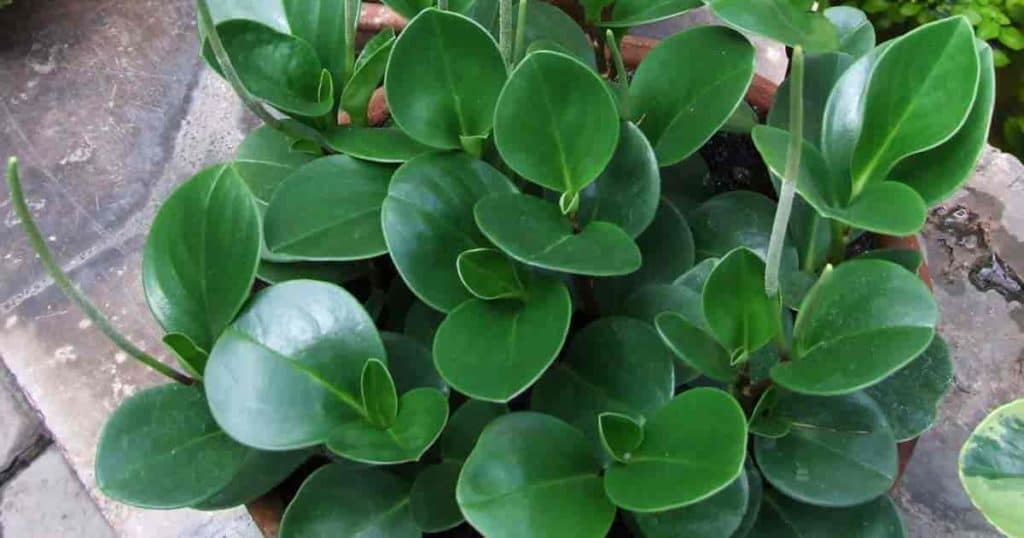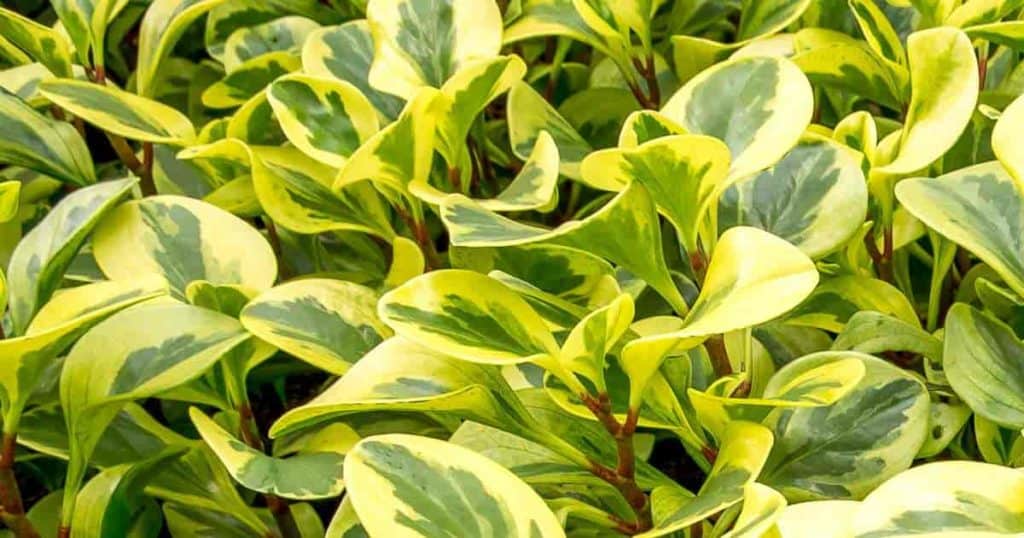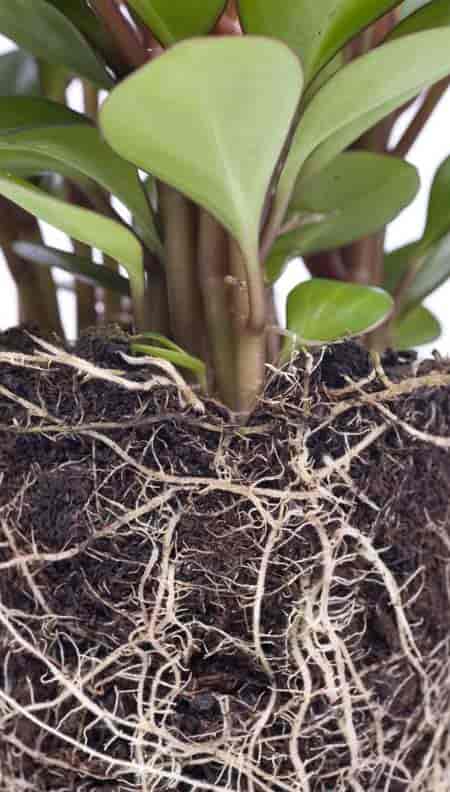There are several characteristics that make Peperomia obtusifolia a versatile and appealing choice as an indoor plant on many levels.
- Low Maintenance: This plant is known for its resilience and ease of care, making it perfect for beginners.
- Light Requirements: Peperomia obtusifolia can tolerate low-light conditions.
- Temperature and Humidity: It prefers temperatures between 65°F and 75°F (18°C to 24°C) and does well in moderate to high humidity environments. This makes it suitable for most indoor settings.
- Compact Size: The plant typically grows to about 6″ to 12″ inches, perfect for small spaces such as desks or shelves.
- Attractive Foliage: Its glossy, spoon-shaped leaves are the main attraction.

Peperomia obtusifolia (pep-er-ROH-mee-uh ob-too-sih-FOH-lee-uh) is a native subtropical rainforest evergreen plant from Central and South America, like southern Florida.
Despite its common name, this epiphytic species isn’t related to the rubber plant (Ficus elastica) but instead is part of the large Peperomia genus, and the epithet obtusifolia means “blunt-leaved.”
‘Obtusifolia’ is grown as a:
- Hanging garden plant
- Ground cover in the shade
- Low-growing potted indoor plant
The Peperomia obtusifolia is one of the 1000 species and numerous Peperomia plant varieties belonging to the family Piperaceae. It is known the common name of:
- Hanging Peperomia
- Baby rubber plant
- Baby rubber tree
- Pepper face plant
- American rubber tree
- American rubber plant
- Green peperomia
There are two varieties of obtusifolia:
- Peperomia obtusifolia green
- Peperomia obtusifolia variegata
Peperomia Obtusifolia Quick Care Tips
- Botanical Name: Peperomia Obtusifolia
- Common Name(s): Baby Rubber Plant, Pepper Face Plant
- Synonyms: –
- Family & Origin: Piperaceae family, native to Central and South America
- Growability: Easy to grow
- Grow Zone: 10-12
- Size: Grows up to 3-4′ feet tall and 12′ inches wide
- Flowering: Produces small, insignificant flowers
- Light: Prefers bright, indirect light but can tolerate low light
- Humidity: Prefers high humidity but can tolerate average humidity
- Temperature: Thrives in temperatures between 55-80°F
- Soil: Well-draining soil
- Water: Water when the top inch of soil is dry, do not overwater
- Fertilizer: Fertilize once a month during the growing season with a balanced liquid fertilizer
- Pests & Diseases: Susceptible to mealybugs and red spider mites, can develop root rot if overwatered
- Propagation: Propagate through stem cuttings or leaf cuttings
- Plant Uses: Used as a decorative indoor plant and air purifier and for its low maintenance care requirements.
In this article, we’ll share everything you need to know about growing and caring for a peperomia obtusifolia.
Peperomia Obtusifolia Care
Baby rubber plant care is quite simple. Just ensure to follow the following tips below:

Size and Growth Rate
Hanging Peperomia Obtusifolia is a compact plant that grows fairly quickly.
The peperomia obtusifolia growth habit is trailing and can grow 3′ to 4′ feet per year under the right conditions.
It has a spread of 12″ inches with dark leaves growing up to 2″ – 4″ inches in length.
Peperomia obtusifolia is typically green in color, which is why it is called “green peperomia.”
Baby Rubber Plant Flower and Fragrance
This plant is characterized by thick, wide, deep green foliage.
The baby rubber plant produces spikes of small white flowers. However, the blooms are insignificant because of their small size and lack of fragrance.
The glossy, spoon-shaped, fleshy, succulent-like leaves are usually dark green, but you can also find cultivars with white and green marble-like variegation.
Light Conditions and Temperature
This evergreen plant loves bright indirect light and can tolerate low light. If placed in direct sun for a long period, the leaves turn pale.
While too little light can result in the variegation fading, don’t be tempted to put them in a position with constant direct sunlight.

Remember that too much sunlight can cause wilting.
The baby rubberplant does well in room temperatures ranging from 55° to 80° degrees Fahrenheit and likes high humidity. Cold drafts may cause leaves to fall off.
The best solution for all your humidity-loving tropical plants is to invest in a small humidifier to place in their midst.
Watering and Feeding
This succulent plant stores water in its leaves and can go for long periods of time without watering, which is why it does not require excessive watering.
Water it moderately during the summer months and reduce the frequency during winter. Watch out for overwatering, as it can lead to root rot!

While the leaves hold moisture and the plant has a level of drought tolerance, don’t frequently leave your baby rubber plant dry for long periods, as this will affect growth, and the foliage won’t be so healthy.
Because Peperomia Obtusifolia plants do not develop an extensive root system, they do not need a lot of fertilizer.
Fed during the spring and summer months with diluted half-strength liquid fertilizer for nutrients. Do NOT fertilize at all during winter.
Peperomia Obtusifolia Soil and Transplanting
Rich, organically dense potting mix soil is the best soil for baby rubber plant.
You can buy cacti pre-mixed soil at the store and add in some organic matter, like a bit of leaf compost, to enhance the baby rubber plant soil.
They do not need transplanting often and grow comfortably in their original pot with drainage holes for years before requiring repotting.
Once new growth is clearly showing, you can move the rooted cutting to a more appropriate permanent pot size.

Grooming and Maintenance
So, how to make a rubber plant bushy? To make your mini rubber plant bushier, pinch them back to encourage them to grow fuller.
Once a plant begins to get older, you should remove any shoots that don’t have leaves or flowering.

How to Propagate Peperomia
Peperomia Obtusifolia propagation can be done through leaf cuttings or stem tip cuttings.
This is ideally done during the spring season.
Also, you may want to experiment and try a few leaves and stem tips to see what propagation method works best for you.
To propagate from stem cuttings, remove the leaf with a sharp knife from about 3″ inches from the tip.
- Make sure there are at least two pairs of leaves and one node.
- After removing the lower pair of leaves, dip the stem cutting into a hormone-rooting powder.
- Plant the stem cutting in equal parts of sand or perlite and peat moss.
- Cover the pot with a plastic bag and keep it at a temperature of 65 degrees Fahrenheit.
- Continue watering until the young plants show new growth and begin to take root.

Obtusifolia Peperomia Pest or Diseases
- Obtusifolia is susceptible to red spider mites that suck the sap out of the leaves. This causes them to turn yellow and dry out.
- Treat with neem oil or other insecticides. Regular misting can help prevent the occurrence of mites.
- Mealybugs are ubiquitous on houseplants. Their cottony tufts turn up on the underside of leaves.
- Other symptoms include falling leaves or blisters as a result of environmental incompatibility.
- Blisters on the leaves mean they’re being overwatered
- Falling leaves signify that the peperomia baby rubber plant is in a cold area and needs to be moved to a warmer spot.
- This plant can be slightly poisonous if ingested.
- Other than this, it’s a fairly forgiving species that is not bothered by many pests or diseases and is a good choice for a beginner’s houseplant.
Related: More Details in our article on Peperomia Pests and Diseases
Suggested Uses for Hanging Peperomia
Peperomia plants such as Obtusifolia and the watermelon peperomia (Peperomia argyreia) are excellent choices for growing by a window as house plants or in a greenhouse.

However, there are many other Peperomia types to grow and enjoy.
Their spelling growth makes them hanging basket candidates. The dark, deep green leaves make peperomia obtusifolia a nice companion plant as potted specimens to mix with bromeliads for color.
